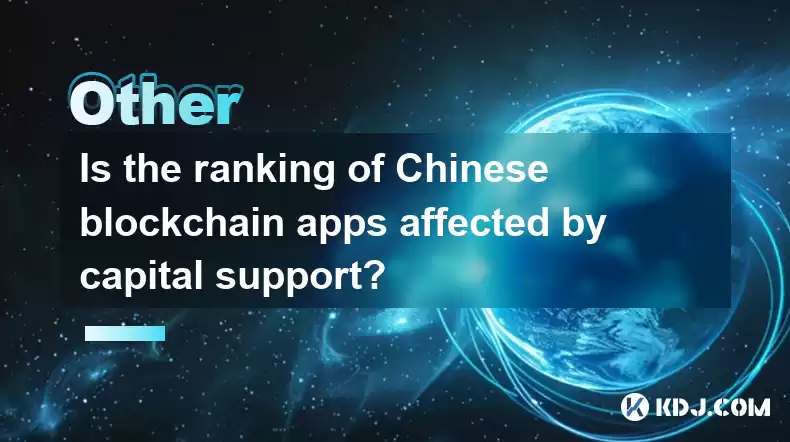-
 bitcoin
bitcoin $87959.907984 USD
1.34% -
 ethereum
ethereum $2920.497338 USD
3.04% -
 tether
tether $0.999775 USD
0.00% -
 xrp
xrp $2.237324 USD
8.12% -
 bnb
bnb $860.243768 USD
0.90% -
 solana
solana $138.089498 USD
5.43% -
 usd-coin
usd-coin $0.999807 USD
0.01% -
 tron
tron $0.272801 USD
-1.53% -
 dogecoin
dogecoin $0.150904 USD
2.96% -
 cardano
cardano $0.421635 USD
1.97% -
 hyperliquid
hyperliquid $32.152445 USD
2.23% -
 bitcoin-cash
bitcoin-cash $533.301069 USD
-1.94% -
 chainlink
chainlink $12.953417 USD
2.68% -
 unus-sed-leo
unus-sed-leo $9.535951 USD
0.73% -
 zcash
zcash $521.483386 USD
-2.87%
Is the ranking of Chinese blockchain apps affected by capital support?
Capital support significantly impacts Chinese blockchain app rankings by enabling marketing and innovation, but over-reliance can lead to unsustainable growth.
Apr 13, 2025 at 03:35 am

The influence of capital support on the ranking of Chinese blockchain apps is a topic of significant interest within the cryptocurrency community. This article delves into the various aspects of how funding impacts the performance and ranking of blockchain applications in China, examining the mechanisms through which capital can drive success or lead to challenges.
The Role of Capital in Blockchain App Development
Capital support plays a crucial role in the development and success of blockchain apps. Funding allows developers to hire skilled personnel, invest in research and development, and scale their operations. In the competitive landscape of Chinese blockchain apps, those with robust financial backing often have a significant advantage. They can afford to experiment with innovative technologies, improve user experience, and expand their market reach.
How Capital Influences App Rankings
The ranking of blockchain apps on various platforms and app stores is influenced by several factors, including user ratings, downloads, and engagement metrics. Capital support can directly impact these metrics by enabling aggressive marketing campaigns, partnerships with other companies, and the implementation of reward systems to boost user engagement. For instance, a well-funded app can afford to offer token incentives, which can increase downloads and user activity, thereby improving its ranking.
Case Studies of Capital-Influenced Rankings
Several Chinese blockchain apps have demonstrated how capital support can affect their rankings. For example, Binance's app, which received significant investment, has consistently ranked high due to its extensive marketing efforts and partnerships with other blockchain projects. Similarly, Huobi's app has benefited from its parent company's financial resources, enabling it to maintain a strong presence in the market.
The Double-Edged Sword of Capital Support
While capital support can propel a blockchain app to the top of the rankings, it also comes with challenges. Over-reliance on funding can lead to unsustainable growth, where the app's success is tied more to its financial backing than to its actual utility or user satisfaction. This can result in a situation where the app's ranking is artificially inflated, only to decline once the funding dries up or the market shifts.
Strategies for Sustainable Growth
To achieve sustainable growth and maintain a high ranking, Chinese blockchain apps must balance capital support with genuine user engagement and innovation. Developing a strong community around the app can provide a more stable foundation for success. This involves creating valuable content, engaging with users through social media, and continuously improving the app based on user feedback.
The Impact of Regulatory Environment
The regulatory environment in China also plays a significant role in how capital support affects blockchain app rankings. Stringent regulations can limit the ways in which apps can use their funding, such as restrictions on token incentives or advertising. Navigating these regulations requires careful planning and compliance, which can be more manageable for well-funded apps with dedicated legal teams.
User Perception and Trust
User perception and trust are critical factors in the ranking of blockchain apps. Capital support can influence these aspects by enabling apps to build a reputable brand through high-quality marketing and partnerships. However, if users perceive that an app's success is solely due to its financial backing rather than its merits, it can lead to skepticism and lower engagement over time.
The Role of Technology and Innovation
While capital support is important, the underlying technology and innovation of a blockchain app are equally crucial for maintaining a high ranking. Apps that continuously innovate and offer unique features can attract and retain users, even if they have less funding than their competitors. This highlights the importance of balancing financial resources with technological advancements.
Analyzing the Data: Metrics and Rankings
To understand how capital support affects rankings, it's essential to analyze the data. Key metrics such as daily active users, transaction volume, and user retention rates provide insights into an app's performance. By comparing these metrics across different apps, it's possible to see how funding influences their rankings. For instance, apps with significant capital support often show higher initial growth rates, but their long-term success depends on other factors like user satisfaction and technological innovation.
The Importance of Marketing and Branding
Marketing and branding are vital components of a blockchain app's strategy, and capital support can significantly enhance these efforts. Well-funded apps can invest in comprehensive marketing campaigns, including social media advertising, influencer partnerships, and participation in industry events. These efforts can increase visibility and attract new users, thereby improving the app's ranking. However, effective marketing must be complemented by a strong product to ensure long-term success.
Frequently Asked Questions
Q: Can a blockchain app with limited funding still achieve a high ranking?A: Yes, a blockchain app with limited funding can still achieve a high ranking if it focuses on delivering a high-quality product and building a strong community. By prioritizing user satisfaction and continuous innovation, such apps can attract and retain users, even without extensive marketing budgets.
Q: How do Chinese regulations affect the use of capital in blockchain apps?A: Chinese regulations can limit the ways in which blockchain apps use their capital, particularly in areas like token incentives and advertising. Well-funded apps with dedicated legal teams are better equipped to navigate these regulations and ensure compliance, which can give them an advantage in maintaining high rankings.
Q: What role does user feedback play in the success of a blockchain app?A: User feedback is crucial for the success of a blockchain app as it helps developers understand user needs and improve the app's features and user experience. Apps that actively engage with their users and incorporate feedback into their development process are more likely to achieve and maintain high rankings.
Q: How can a blockchain app balance capital support with sustainable growth?A: To balance capital support with sustainable growth, a blockchain app should focus on building a strong community, continuously innovating, and ensuring that its growth is driven by genuine user engagement rather than just financial backing. This approach helps create a more stable foundation for long-term success.
Disclaimer:info@kdj.com
The information provided is not trading advice. kdj.com does not assume any responsibility for any investments made based on the information provided in this article. Cryptocurrencies are highly volatile and it is highly recommended that you invest with caution after thorough research!
If you believe that the content used on this website infringes your copyright, please contact us immediately (info@kdj.com) and we will delete it promptly.
- Bitcoin Flashes 'Inverted Flag' Amidst Swirling Macro Uncertainty: A New York Minute
- 2025-12-18 15:55:01
- Coinbase Unveils Ambitious "Everything App" Vision with Major Foray into Stock Trading and Prediction Markets
- 2025-12-18 12:50:01
- Canada Tightens Grip on Stablecoins: Focus on Robust Reserve Backing and User Protection
- 2025-12-18 15:55:01
- DeSpend Unveils Decentralized Commercial Empire: The Nexus of DAO Governance and Value Fission
- 2025-12-18 15:50:02
- Creditcoin and Midnight Forge Alliance: Decentralized Identity's Bold Stand Against AI Deepfakes
- 2025-12-18 12:50:01
- Coinbase Rockets into New Financial Frontiers: Stock Trading and Prediction Markets Now Live
- 2025-12-18 15:50:02
Related knowledge

Will cryptocurrency replace traditional banks?
Dec 09,2025 at 05:20pm
The Shift in Financial Power1. Cryptocurrency has introduced a decentralized model that challenges the centralized authority of traditional banks. By ...

How to measure the risk of a cryptocurrency?
Dec 15,2025 at 08:40am
Understanding Market Volatility1. Cryptocurrency prices are highly sensitive to market sentiment, macroeconomic news, and regulatory developments. A s...

What is Chainlink (LINK) and what are oracles?
Dec 02,2025 at 05:00pm
Chainlink (LINK) is a decentralized oracle network that enables smart contracts on blockchains to securely connect with real-world data and systems. U...

Coinbase vs. Binance: Which is better for a beginner?
Nov 28,2025 at 01:39am
Understanding the Core Differences1. Coinbase operates primarily as a regulated cryptocurrency exchange based in the United States, adhering to strict...

How to dollar-cost average (DCA) into cryptocurrency?
Nov 28,2025 at 10:20pm
Understanding Dollar-Cost Averaging in Crypto1. Dollar-cost averaging (DCA) is a strategy where an investor regularly buys a fixed amount of cryptocur...

Why do you need to pay "gas fees" for transactions?
Nov 29,2025 at 09:39am
Understanding the Purpose of Gas Fees in Blockchain Transactions1. Every transaction on a blockchain network, such as transferring tokens or executing...

Will cryptocurrency replace traditional banks?
Dec 09,2025 at 05:20pm
The Shift in Financial Power1. Cryptocurrency has introduced a decentralized model that challenges the centralized authority of traditional banks. By ...

How to measure the risk of a cryptocurrency?
Dec 15,2025 at 08:40am
Understanding Market Volatility1. Cryptocurrency prices are highly sensitive to market sentiment, macroeconomic news, and regulatory developments. A s...

What is Chainlink (LINK) and what are oracles?
Dec 02,2025 at 05:00pm
Chainlink (LINK) is a decentralized oracle network that enables smart contracts on blockchains to securely connect with real-world data and systems. U...

Coinbase vs. Binance: Which is better for a beginner?
Nov 28,2025 at 01:39am
Understanding the Core Differences1. Coinbase operates primarily as a regulated cryptocurrency exchange based in the United States, adhering to strict...

How to dollar-cost average (DCA) into cryptocurrency?
Nov 28,2025 at 10:20pm
Understanding Dollar-Cost Averaging in Crypto1. Dollar-cost averaging (DCA) is a strategy where an investor regularly buys a fixed amount of cryptocur...

Why do you need to pay "gas fees" for transactions?
Nov 29,2025 at 09:39am
Understanding the Purpose of Gas Fees in Blockchain Transactions1. Every transaction on a blockchain network, such as transferring tokens or executing...
See all articles









































































